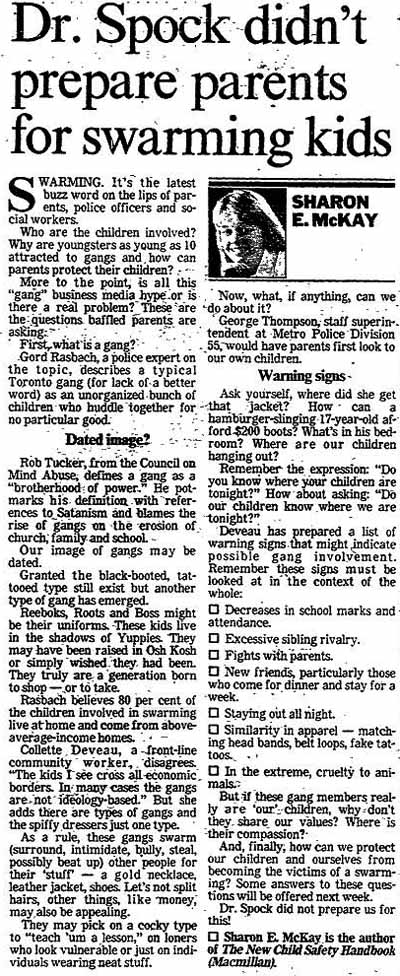This installment of my "Retro T.O." column for The Grid was originally published on April 24, 2012.
 |
| Globe and Mail, May 27, 1989. |
Depending on the city, the practice had different names—“bum rushing” in New York, “trashing” in Los Angeles, “steaming” in London. As the 1980s came to a close, the media in Toronto reported that a growing number of local youths participated in “swarming” attacks on individuals and businesses to steal jackets, jewellery, money, shoes, and, in the case of the Yonge and Eglinton branch of Fran’s, pastry. These incidents heightened fears about increased gang activity and how to handle restless, disaffected youth throughout all socio-economic levels in the city.
These swarmings involved spontaneous attacks by groups of around 15 to 20 youths. According to a December 1988
Star article, “the attackers surround their victim like a swarm of bees, disorienting them while inflicting injury or stealing valuables.” As the swarmings increased, Metro Toronto Police Sgt. Pat Tallon noticed that participants felt they had an inherent right to grab what they wanted regardless of consequences. “There’s no stigma attached to getting into trouble,” Tallon noted. “They come from all walks of life, but they have no shame for themselves or their families.”
 |
| Globe and Mail, May 27, 1989. |
Articles traced the local origins of swarming to a gang of North Toronto youths known as The Untouchables. Stories varied wildly about the gang’s beginnings; according to an account published in the
Star in March 1989, it formed when preppies from Northern Secondary School avenged a six-dollar robbery perpetrated by a skinhead. In a recent edition of her column, "Then & Now",
The Grid‘s Denise Benson traced the gang’s origins to late-’80s all-ages haunt
Club Focus. Whatever the story, Eglinton subway station was a scene of early attacks, prompting parents to urge their kids to avoid the transit hub.
Police noted that swarmings frequently happened in shopping malls. While victims ranged from elementary school pupils to grandmothers, most were between the ages of 14 and 18. Groups preferred timid victims who would never tell a soul that they were swarmed. “The biggest sucker is the kid who has been robbed of lunch money—and doesn’t tell,” noted Constable Gord Rasbach. “Then they’ll extort $5 from him every Monday. It seems primitive, yet for the victim it is terrifying. The kids are afraid that if they do tell, things will escalate, that they will be thumped in front of a girlfriend, that they won’t be able to walk home.” Rasbach found that the mere thrill of ripping a gold chain off somebody’s throat was motivation enough for some swarmers. Parents were advised not to impose curfews on their children, but to spend time with them, or enrol them in extra-curricular activities to keep them occupied. Using a highly stereotyped example, the
Star suggested that parents ask themselves “How can a hamburger-slinging 17-year-old afford $200 boots?”
 |
| Toronto Star, May 23, 1989. |
Rasbach provided a list of warning signs that a swarming was imminent: watch for eye contact between groups of youth in malls or subways; beware young strangers who admire your clothes or jewellery; watch out for youths who bump into others and say “Hey, watch it,” or similar lines; and look around after being jostled—if the jostler is not alone, seek the nearest crowd.
Despite urgings by Toronto Mayor Art Eggleton for teens to respect other people and their property, swarmings garnered headlines for a few years. In two major incidents during the fall of 1991, the Eaton Centre was temporarily closed after over 100 teens looted a Stitches store, and 28 people, some wielding baseball bats and hammers, were charged after $100,000 worth of jewellery was lifted during a rampage through a Scarborough flea market. Mall owners looked on with anxiety as proposed changes to provincial trespassing laws would make it more difficult for security guards to remove potential lawbreakers from their premises. The furor gradually faded, as the eternal quest for new methods of youthful intimidation tactics found other methods of creating mayhem.
Additional material from the December 29, 1988, March 11, 1989, May 5, 1989, May 23, 1989, June 11, 1989, and October 19, 1991 editions of the Toronto Star.



Comments